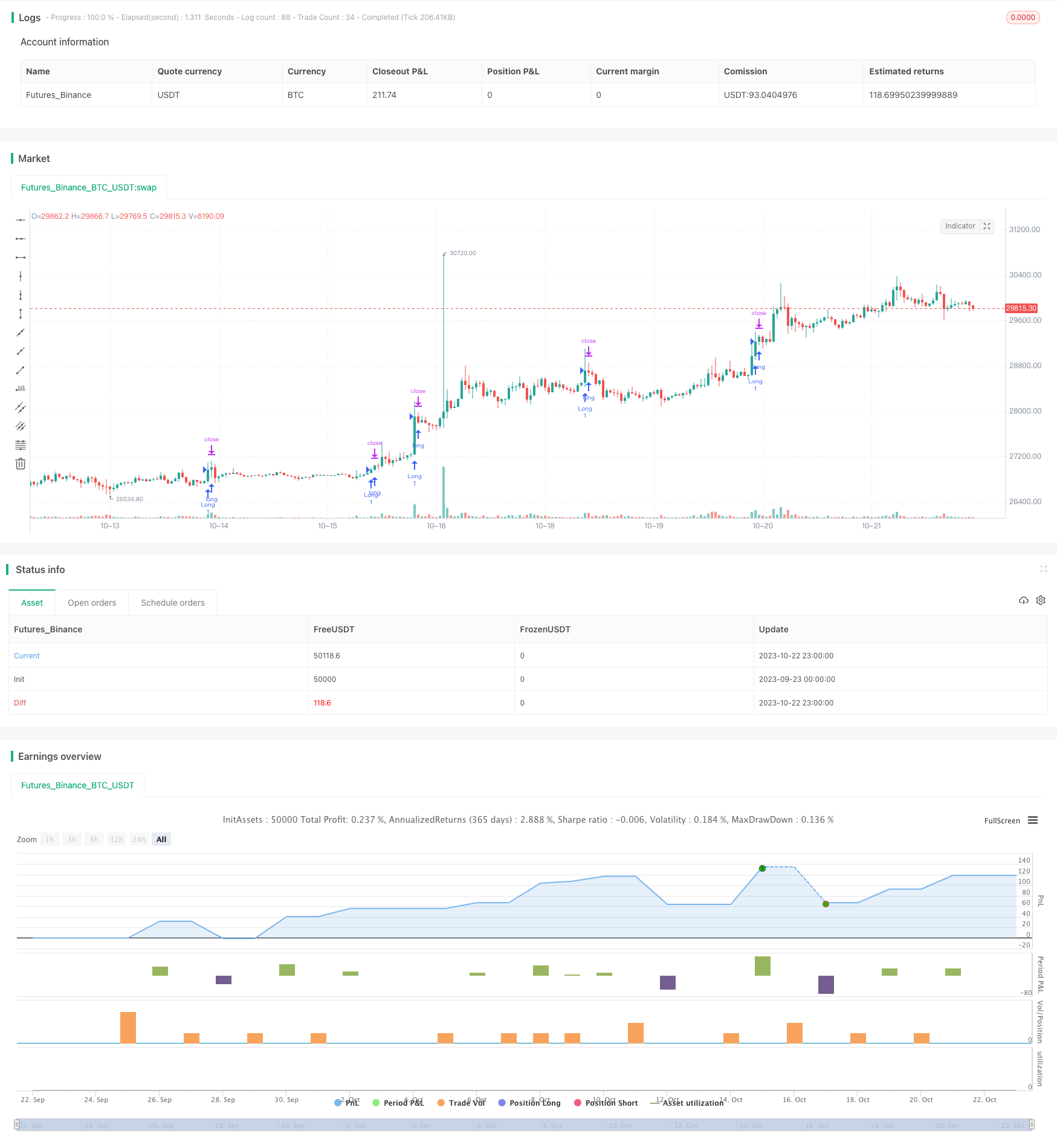
概述
该策略主要基于卡马利拉通道和移动均线来判断市场的突破点,进而实现趋势跟踪。策略相对简单,但具有较强的实用性。
策略原理
计算卡马利拉通道的支撑和阻力线。包括H4,L4等线。
判断价格是否突破该通道线。例如收盘价上穿H4线且开盘价低于H4线,认为有突破信号。
加入移动均线判断,进一步确认突破信号。例如EMA低于收盘价则为多头突破。
进入做多头仓位,设置止损和止盈条件,如设置固定止损点数,以及追踪止损方式。
针对空头也是同样判断逻辑。
以上是策略的主要判断逻辑,相对简单直观,容易理解和实现。通过动态追踪止损,可以持续获利直至趋势反转。
优势分析
该策略具有以下优势:
基于卡马利拉通道,可以准确定位潜在的支撑和阻力。
结合均线过滤,可以有效区分突破信号的真假。
采用追踪止损方式,可以持续获利,避免反转止损。
策略信号简单明确,容易判断操作。
无需频繁调整参数,适合参数固定的自动交易。
风险及解决方案
该策略也存在以下风险:
卡马利拉通道无法有效判断趋势反转点,可能导致亏损扩大。
- 解决方法:结合其他指标如震荡指标判断趋势反转
追踪止损点数设置不合理可能导致过早止损或亏损扩大。
- 解决方法:优化和测试不同的止损点数设置
突破信号可能存在假突破情况。
- 解决方法:加入更多滤波指标进行确认,或适当放宽突破判定标准。
大幅震荡市场中存在多次假突破。
- 解决方法:在震荡期避免交易,或适当放宽突破标准。
优化建议
该策略还可以从以下方面进行优化:
增加复合过滤指标,提高突破准确率。可以考虑KDJ,MACD等。
优化止损止盈策略,如引入动态止损,结合ATR指标等。
对不同品种参数进行优化,提高稳定性。
增加对大周期趋势的判断,避免逆势交易。
结合当日量能分析,聚焦高量能突破。
开发自动参数优化程序,实时优化参数。
扩展成多品种套利策略,利用价差。
总结
本策略整体思路清晰简单,实用性强,是典型的突破跟踪策略。通过卡马利拉通道判断潜在支撑阻力,再结合均线过滤确定突破方向。止损方式也较为合理。但该策略可扩展性也很强,可以引入更多指标进行优化,使策略更稳健可靠。也可以扩展为多品种策略。总体来说,本策略具有很好的改进潜力。
/*backtest
start: 2023-09-23 00:00:00
end: 2023-10-23 00:00:00
period: 1h
basePeriod: 15m
exchanges: [{"eid":"Futures_Binance","currency":"BTC_USDT"}]
*/
//@version=2
//Created by CristianD
strategy(title="CamarillaStrategyV1", shorttitle="CD_Camarilla_StrategyV1", overlay=true)
//sd = input(true, title="Show Daily Pivots?")
EMA = ema(close,8)
//Camarilla
pivot = (high + low + close ) / 3.0
range = high - low
h5 = (high/low) * close
h4 = close + (high - low) * 1.1 / 2.0
h3 = close + (high - low) * 1.1 / 4.0
h2 = close + (high - low) * 1.1 / 6.0
h1 = close + (high - low) * 1.1 / 12.0
l1 = close - (high - low) * 1.1 / 12.0
l2 = close - (high - low) * 1.1 / 6.0
l3 = close - (high - low) * 1.1 / 4.0
l4 = close - (high - low) * 1.1 / 2.0
h6 = h5 + 1.168 * (h5 - h4)
l5 = close - (h5 - close)
l6 = close - (h6 - close)
// Daily line breaks
//sopen = request.security(syminfo.tickerid, "D", open [1])
//shigh = request.security(syminfo.tickerid, "D", high [1])
//slow = request.security(syminfo.tickerid, "D", low [1])
//sclose = request.security(syminfo.tickerid, "D", close [1])
//
// Color
//dcolor=sopen != sopen[1] ? na : black
//dcolor1=sopen != sopen[1] ? na : red
//dcolor2=sopen != sopen[1] ? na : green
//Daily Pivots
dtime_pivot = request.security(syminfo.tickerid, 'D', pivot[1])
dtime_h6 = request.security(syminfo.tickerid, 'D', h6[1])
dtime_h5 = request.security(syminfo.tickerid, 'D', h5[1])
dtime_h4 = request.security(syminfo.tickerid, 'D', h4[1])
dtime_h3 = request.security(syminfo.tickerid, 'D', h3[1])
dtime_h2 = request.security(syminfo.tickerid, 'D', h2[1])
dtime_h1 = request.security(syminfo.tickerid, 'D', h1[1])
dtime_l1 = request.security(syminfo.tickerid, 'D', l1[1])
dtime_l2 = request.security(syminfo.tickerid, 'D', l2[1])
dtime_l3 = request.security(syminfo.tickerid, 'D', l3[1])
dtime_l4 = request.security(syminfo.tickerid, 'D', l4[1])
dtime_l5 = request.security(syminfo.tickerid, 'D', l5[1])
dtime_l6 = request.security(syminfo.tickerid, 'D', l6[1])
//offs_daily = 0
//plot(sd and dtime_pivot ? dtime_pivot : na, title="Daily Pivot",color=dcolor, linewidth=2)
//plot(sd and dtime_h6 ? dtime_h6 : na, title="Daily H6", color=dcolor2, linewidth=2)
//plot(sd and dtime_h5 ? dtime_h5 : na, title="Daily H5",color=dcolor2, linewidth=2)
//plot(sd and dtime_h4 ? dtime_h4 : na, title="Daily H4",color=dcolor2, linewidth=2)
//plot(sd and dtime_h3 ? dtime_h3 : na, title="Daily H3",color=dcolor1, linewidth=3)
//plot(sd and dtime_h2 ? dtime_h2 : na, title="Daily H2",color=dcolor2, linewidth=2)
//plot(sd and dtime_h1 ? dtime_h1 : na, title="Daily H1",color=dcolor2, linewidth=2)
//plot(sd and dtime_l1 ? dtime_l1 : na, title="Daily L1",color=dcolor2, linewidth=2)
//plot(sd and dtime_l2 ? dtime_l2 : na, title="Daily L2",color=dcolor2, linewidth=2)
//plot(sd and dtime_l3 ? dtime_l3 : na, title="Daily L3",color=dcolor1, linewidth=3)
//plot(sd and dtime_l4 ? dtime_l4 : na, title="Daily L4",color=dcolor2, linewidth=2)
//plot(sd and dtime_l5 ? dtime_l5 : na, title="Daily L5",color=dcolor2, linewidth=2)
//plot(sd and dtime_l6 ? dtime_l6 : na, title="Daily L6",color=dcolor2, linewidth=2)
longCondition = close >dtime_h4 and open < dtime_h4 and EMA < close
if (longCondition)
strategy.entry("Long", strategy.long)
strategy.exit ("Exit Long","Long", trail_points = 140,trail_offset = 1, loss =170)
//trail_points = 40, trail_offset = 3, loss =70 and
shortCondition = close <dtime_l4 and open >dtime_l4 and EMA > close
if (shortCondition)
strategy.entry("Short", strategy.short)
strategy.exit ("Exit Short","Short", trail_points = 110,trail_offset = 1, loss =120)